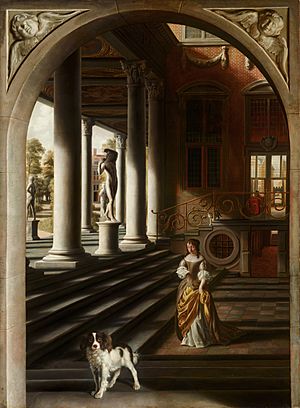Anne Conway (philosopher) facts for kids
Quick facts for kids
Anne Conway
|
|
|---|---|

Perspective View with a Woman Reading a Letter by Samuel van Hoogstraten. This painting is often thought to show Anne Conway.
|
|
| Born |
Anne Finch
14 December 1631 London, England
|
| Died | 23 February 1679 (aged 47) Ragley Hall, Warwickshire, England
|
| Resting place | Holy Trinity Church, Arrow, Warwickshire |
| Occupation | Philosopher |
| Spouse(s) | |
| Children | Heneage Edward Conway |
| Parent(s) | Sir Heneage Finch Elizabeth Cradock |
| Relatives | John Finch (brother) |
Anne Conway (born Anne Finch; December 14, 1631 – February 23, 1679) was an English philosopher. Her ideas were part of a group called the Cambridge Platonists. Her work also influenced another famous thinker, Gottfried Leibniz. Conway's philosophy was very original. It was a unique way of thinking for the 1600s.
Contents
Anne Conway's Life
Anne Finch was born in London. Her father, Sir Heneage Finch, was an important official. He had been the Recorder of London (a judge) and the Speaker of the House of Commons. This meant he led meetings in the English Parliament. Sadly, her father died just a week before she was born. Anne was the youngest child in her family.
Early Education and Interests
Anne was taught at home by private teachers. She learned Latin, and later studied Greek and Hebrew. Her half-brother, John Finch, encouraged her love for philosophy and theology (the study of religion). He introduced Anne to Henry More, a philosopher from Cambridge University. More was one of John's teachers.
This meeting led to a long friendship and many letters between Anne and Henry More. They often discussed the ideas of René Descartes, another famous philosopher. Anne started as More's student but soon became his equal in thinking. Henry More once said that Anne was one of the smartest people he had ever met. He believed she was better than most men in understanding both nature and divine things. Anne grew up in a house now known as Kensington Palace. Her family owned it at that time.
Marriage and Family Life
In 1651, Anne married Edward Conway. He later became the first Earl of Conway. The next year, Henry More dedicated his book Antidote against Atheism to her. About a year after their wedding, Anne and Edward moved into Edward's home at Kensington Palace.
In 1658, Anne had her only child, Heneage Edward Conway. Sadly, he died of smallpox just two years later. Anne also caught smallpox but she survived the illness.
Her husband, Edward, was also interested in philosophy. He had also been taught by Henry More. But Anne's thinking was much deeper and covered more topics than his. She connected with Elizabeth Foxcroft, likely through Henry More. When Elizabeth's husband went to India in 1666, Foxcroft moved in with Anne. She became Anne's companion and helped her write things down. They shared many interests. Foxcroft lived at Ragley Hall until 1672.
Religious Journey
Anne became interested in Lurianic Kabbalah, a type of Jewish mysticism. Later, she became interested in Quakerism. She officially became a Quaker in 1677. In England during that time, Quakers were often disliked and feared. They faced unfair treatment and even went to prison.
Anne's decision to become a Quaker was very brave. She made her home a place for Quaker meetings and actively shared her beliefs. Even her own family did not fully support her choice. However, they still respected her decision.
Health Challenges
From the age of twelve, Anne suffered from severe migraine headaches. These headaches often caused her great pain and made her unable to do much. She spent a lot of time seeking medical help and trying to find a cure. At one point, doctors even tried unusual treatments like opening her jugular veins.
Because of her pain, she often studied philosophy from her home. Many famous doctors of her time tried to help her. These included Dr. Thomas Willis, Theodore Turquet de Mayerne, Robert Boyle, and William Harvey. Harvey was known for his research on how blood moves in the human body. Even though many great doctors treated Anne, none of the treatments worked. She died in 1679 when she was 47 years old.
Anne Conway's Book
Anne Conway's main philosophical work is called The Principles of the Most Ancient and Modern Philosophy. She likely wrote this book in 1677. It shows the influence of another thinker, Franciscus Mercurius van Helmont.
The book was first published in Latin in 1690 in Amsterdam. An English translation came out in 1692. In The Principles, Conway shares her idea that the world is made from one single substance. This is called a "monistic view." She disagreed with the idea that bodies are just "dead matter." She also disagreed with the idea that the mind and body are completely separate.
Her Letters
Throughout her life, Anne Conway wrote many letters. She wrote to Henry More, Francis Mercury van Helmont, and other important thinkers. Most of her letters were to Henry More. They discussed many philosophical and religious ideas. Sometimes, Anne would also share personal news, like the death of her son.
She also wrote about a dozen letters to her father-in-law, Lord Conway. Her brother, John Finch, also wrote about a dozen letters to her. These letters contained personal information, discussions about philosophy, and thoughts on social issues.
A scholar named Marjorie Hope Nicolson collected many of Anne's letters. In 1930, she wrote a book using 307 of Conway's letters. This book also included information about Anne's life. In 1992, Sarah Hutton created a new version of Nicolson's book. Nicolson's original book focused on Anne's social life and her relationships with friends and family, especially Henry More.

